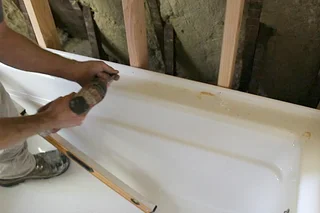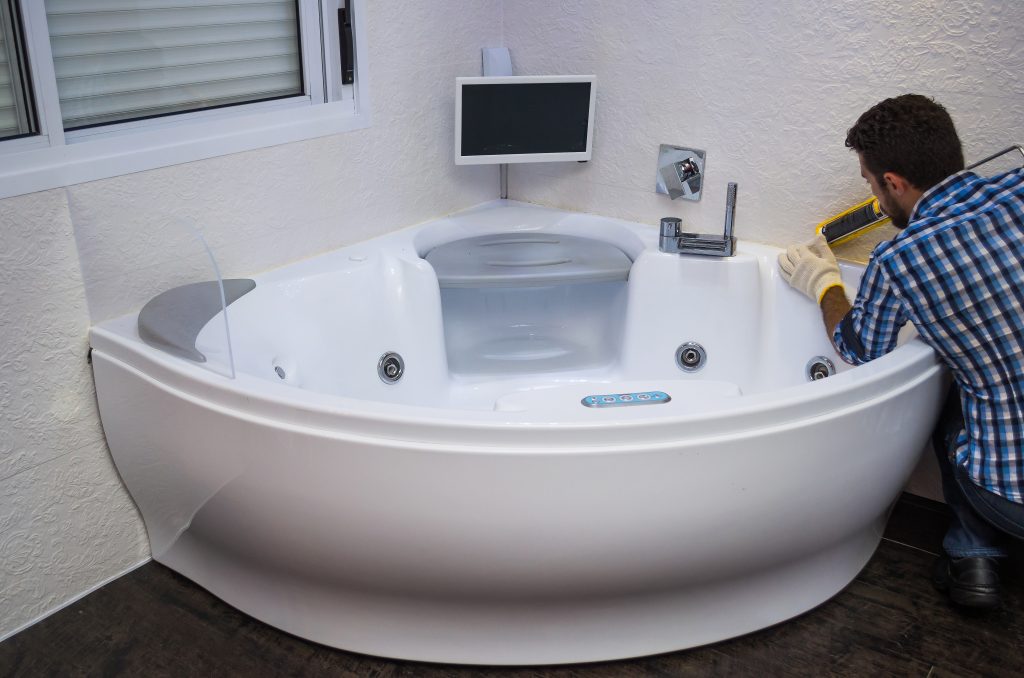What're your opinions about A Step-by-Step Guide to Installing a Bathtub?

Mounting a bathtub isn't precisely rocket science, however it does require strong plumbing, carpentry, as well as occasionally, tiling skills. Changing an old bathtub with a brand-new one is also a reasonably hard job. If the old bathtub is readily easily accessible, the project can relocate speedily; if you have to open up a wall to eliminate the old bathtub as well as place the new tub, the task is much harder. In either instance, the project is within a residence handyman's skills, although you will require a helper to leave the old bathtub as well as embeded in the new one. Ensure you have certified yourself for the task and also are comfortable trying it. Rather than hiring a professional to take control of a halfway-completed task, it is far better to consider employing one before you begin. Possibilities are you may require a specialist plumber to make tube connections.
This short article will assist you set up a new bathtub in your restroom if you have already bought a new tub and also do not require to transform the plan of your previous water system pipes.
Your devices and also product list must comprise the following:
Getting ready for the Installation
Firstly, the sustaining structure supplied with the bath needs to be fitted (if needed) according to the maker's directions. Next, fit the taps or mixer to the bathtub. When fitting the tap block, it is important to make sure that if the faucet includes a plastic washer, it is fitted between the bathroom and also the taps. On a plastic bath, it is likewise reasonable to fit a sustaining plate under the faucets device to prevent stress on the tub.
Fit the versatile faucet adapters to the bottom of the two faucets making use of 2 nuts and also olives (in some cases provided with the bathtub). Fit the plug-hole electrical outlet by smearing mastic filler round the sink electrical outlet opening, and then pass the outlet via the hole in the bath. Make use of the nut supplied by the maker to fit the plug-hole. Analyze the plug-hole electrical outlet for an inlet on the side for the overflow pipe.
Next off, fit the end of the versatile overflow pipeline to the overflow outlet. Afterwards, screw the pipeline to the overflow face which ought to be fitted inside the bathroom. Make certain you use every one of the supplied washing machines.
Link the catch to the bottom of the waste outlet on the bath tub by winding the thread of the waste outlet with silicone mastic or PTFE tape, and screw on the catch to the outlet. Connect all-time low of the overflow tube in a similar manner.The bath must now prepare to be suited its final placement.
Removing Old Touches
If you require to replace old taps with brand-new ones as a part of your installment, after that the first thing you ought to do is disconnect the water. After doing so, activate the taps to drain any kind of water staying in the system. The procedure of getting rid of the existing faucets can be rather troublesome because of the restricted access that is often the instance.
Utilize a basin wrench (crowsfoot spanner) or a tap tool to undo the nut that connects the supply pipes to the faucets. Have a fabric prepared for the remaining water that will originate from the pipelines. When the supply pipes have actually been removed, use the same device to loosen up the nut that holds the faucets onto the bath/basin. You will certainly need to stop the single taps from transforming throughout this process. Once the faucets have actually been eliminated, the holes in the bath/basin will have to be cleaned of any old securing substance.
Before proceeding to fit the new taps, contrast the pipeline connections on the old taps to the new faucets. If the old faucets are longer than the new taps, after that a shank adapter is needed for the brand-new taps to fit.
Setting up the Tub
Making use of the two wood boards under its feet, place the bath tub in the needed position. The wood boards are helpful in evenly spreading the weight of the bath tub over the area of the boards instead of focusing all the weight onto four small factors.
The following objective is to make sure that the bathtub is leveled all round. This can be achieved by inspecting the spirit level and changing the feet on the bathtub up until the level reviews level.
To set up taps, fit all-time low of the furthest versatile faucet connector to the appropriate supply pipe by making a compression sign up with; after that do the very same for the other tap.
Turn on the water supply and check all joints and also new pipework for leaks and tighten them if needed. Fill up the bathtub and also examine the overflow electrical outlet and also the normal outlet for leakages.
Finally, repair the bathroom paneling as defined in the producer's instruction manual. Tiling as well as sealing around the bathtub must wait until the bath tub has been made use of a minimum of once as this will resolve it right into its final placement.
Suitable New Touches
If the tails of the brand-new taps are plastic, then you will certainly require a plastic adapter to prevent damage to the string. One end of the adapter fits on the plastic tail of the faucet and also the various other end offers a connection to the current supply pipelines.
If you need to fit a monobloc, then you will need decreasing couplers, which connects the 10mm pipe of the monobloc to the standard 15mm supply pipeline.
Next off, place the tap in the placing hole in the bath/basin guaranteeing that the washing machines are in location between the tap and the sink. Secure the tap in place with the manufacturer provided backnut. Once the faucet is firmly in position, the supply pipelines can be linked to the tails of the taps. The taps can either be connected by utilizing corrugated copper piping or with regular faucet ports. The former type should be attached to the faucet finishes first, tightening just by hand. The supply pipelines can later on be connected to the other end. Tighten up both ends with a spanner after both ends have actually been linked.
Tiling Around the Bathtub
In the area where the bathroom satisfies the ceramic tile, it is essential to secure the joins with a silicone rubber caulking. This is important as the installation can move sufficient to break an inflexible seal, triggering the water to penetrate the wall surface between the bathroom and the tiling, causing problems with wetness as well as feasible leaks to the ceiling listed below.
You can select from a selection of coloured sealants to assimilate your fixtures as well as fittings. They are sold in tubes as well as cartridges, as well as are capable of sealing spaces up to a size of 3mm (1/8 inch). If you have a larger void to fill, you can load it with spins of soaked paper or soft rope. Keep in mind to constantly fill the bathtub with water before securing, to permit the movement experienced when the tub remains in usage. The sealant can split rather very early if you do not take into account this motion before securing.
Conversely, ceramic coving or quadrant floor tiles can be made use of to border the bath or shower tray. Plastic strips of coving, which are easy to use and cut to size, are likewise conveniently readily available on the marketplace. It is advisable to fit the tiles utilizing water-resistant or water resistant sticky and also cement.
Bathtub Installation
How Important Is A Bathtub To Your Home?
High-quality baths, showers, and other bathroom updates are necessary when considering a smart investment in your home. It’s a room that you go to every day and one that is constantly being used by guests.The bathroom is one of the top trafficked rooms in a home and also one of the most valuable in terms of home resale.
Install Piping Before Tub
You will be using your existing drain and waste vent system, but pipes required include the hot and cold water supply lines and a pipe leading to a shower head. A mixing valve and shower head are also needed. Air chambers may be required.
Position the Tub
Lower the tub into place so that the continuous flange fits against the wall studs and rests on 1’x4' or 2’x4' supports. Anchor the tub to the enclosure with nails or screws inserted through the flanges into the studs.
NOTE: Remember, bathtubs and shower stalls may require support framing. A bathtub filled with water is extremely heavy, so check building codes and framing support before installing the tub.
Assemble Drain Connections
Assemble the bathtub drain connections by connecting the tub overflow with the tub drain above the trap, not beyond it. The trap will have a compression fitting that screws over the arm of the overflow assembly.
Place a Pipe For the Shower Head
First, locate a brass female threaded winged fitting and attach it to a framing support via a screw or a nail. Then run a pipe up the wall for the shower head. Sweat or solder the other side of the brass fitting to the top of the pipe.
Attaching Hot and Cold Water Lines
Attach your water lines for both hot and cold by sweating these directly into the hot and cold ports of the mixing valve. The mixing valve will be how water enters the tub’s system, not by the pipes themselves.
Install the Spout
Extend a piece of 1/2 inch pipe, or whichever length is specified in the manufacturer’s instructions, for the tub spout. Sweat on a male threaded fitting at the end of the pipe or use a brass nipple of the proper length and a 1/2 inch cap.
NOTE: At this point you should have your rough-in plumbing work inspected before proceeding further.
Check For Leaks
Restore the water pressure and check the drain connection and the supply pipes for any sign of leaking.
estore the Bathroom Wall
Replace the wall with moisture-resistant drywall as a base for your wall covering. Seal the joints between the wall and your new tub with silicone caulk as protection against water seepage.
https://www.berkeys.com/2016/12/02/bathtub-installation-dallas/

As a reader on How to Install a Bathtub Yourself, I figured sharing that portion was essential. Those who liked our blog post plz remember to pass it around. I am grateful for your time. Come back soon.
Click Here!